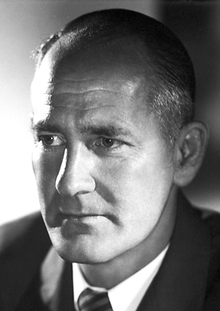George Beadle | |
|---|---|
 | |
| Born | George Wells Beadle October 22, 1903[2] |
| Died | June 9, 1989 (aged 85) Pomona, California, U.S. |
| Alma mater | University of Nebraska (BS) Cornell University (MS, PhD) |
| Known for |
|
| Awards |
|
| Scientific career | |
| Fields | Genetics |
| Institutions | |
| Thesis | Genetical and Cytological Studies of Mendelian Asynapsis in Zea mays (1930) |
| Doctoral advisor | |
| Other academic advisors |
|
| Doctoral students | |
| Other notable students |
|
George Wells Beadle (October 22, 1903 – June 9, 1989) was an American geneticist. In 1958 he shared one-half of the Nobel Prize in Physiology or Medicine with Edward Tatum for their discovery of the role of genes in regulating biochemical events within cells.[3][4] He also served as the 7th President of the University of Chicago.[5]
Beadle and Tatum's key experiments involved exposing the bread mold Neurospora crassa to x-rays, causing mutations. In a series of experiments, they showed that these mutations caused changes in specific enzymes involved in metabolic pathways. These experiments led them to propose a direct link between genes and enzymatic reactions, known as the One gene-one enzyme hypothesis.[6][7][8]
- ^ a b c d "DevTree - George Wells Beadle". academictree.org.
- ^ Cite error: The named reference
frswas invoked but never defined (see the help page). - ^ George W. Beadle — Biographical Memoirs of the National Academy of Sciences
- ^ Stern, C. (1954). "George W. Beadle". Science. 119 (3086): 229–230. Bibcode:1954Sci...119..229S. doi:10.1126/science.119.3086.229. PMID 13135519.
- ^ "George W. Beadle | Office of the President | The University of Chicago". president.uchicago.edu. 12 June 2012. Retrieved 2019-06-22.
- ^ Beadle, G. W.; Tatum, E. L. (1941). "Genetic Control of Biochemical Reactions in Neurospora" (PDF). Proceedings of the National Academy of Sciences. 27 (11): 499–506. Bibcode:1941PNAS...27..499B. doi:10.1073/pnas.27.11.499. PMC 1078370. PMID 16588492.
- ^ Paul Berg and Maxine Singer. George Beadle: An Uncommon Farmer. The Emergence of Genetics in the 20th Century. Cold Springs Harbor Laboratory Press, 2003. ISBN 0-87969-688-5
- ^ Key Participants: George Beadle - It's in the Blood! A Documentary History of Linus Pauling, Hemoglobin, and Sickle Cell Anemia